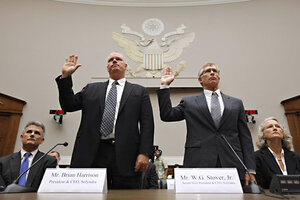Solyndra bankruptcy: what went wrong
How did the Department of Energy evaluate Solyndra's loan request?

Solyndra CEO Brian Harrison. left, and Chief Financial Officer Bill Stover, right, are sworn in on Capitol Hill in Washington, prior to testifying before the House Oversight and Investigations subcommittee. The author argues that the DOE should make its criteria for choosing loan recipients more visible.
J. Scott Applewhite/AP
Everybody now knows that the DOE blew it when it guaranteed roughly $530 million dollars of loans to the "green" solar firm Solyndra. But, we do not know what criteria the DOE used to judge whether this was (ex-ante) a good use of public funds. Read this letter sent to Secretary Chu in 2010. Many people have wondered how the DOE evaluates potentially promising proposals. A for profit bank will use statistical models to try to predict the probability of default.
In the case of this loan, the DOE had more a complex objective. It wanted to spur new U.S green economy research and it wanted to stimulate the economy and it wanted to be paid back. What information did DOE officials receive that allowed them to make a decision? Did the company provide projections concerning job growth over the short run? How could DOE evaluate the merits of such claims? It is well known in the transportation literature that project boosters always overstate ex-ante the likely ridership of new subway lines to encourage politicians to invest in them (see the work of Don Pickrell and John Kain).
Now Secretary Chu is an expert on energy issues. Has he assembled a team of experts who sat down and thought about how promising was the core strategy of each loan that was being considered? Other bloggers say that the answer was "no". Here is a subtle post. To quote the author; "The difference isn't the nature of the risks, but rather the nature of the investor -- the federal government, straying far from its domain of demonstrated competence. This is the core issue I see in the Solyndra situation, but one that seems to be getting overlooked. The Title 17 loan guarantee program, in all of its various forms including a swath of more recent even larger plans to have a federal "Clean Energy Bank", is poorly structured to achieve success. It puts a handful of largely invisible bureaucrats and advisors in the position of making unprecedented wealth transfers to fund high risk private ventures."
My concern is that the DOE was spending other people's money and thus didn't have sharp incentives to think through the merits of each loan. I wonder if it was under pressure to get the $ out there to get the Keynesian demand push going.
The DOE should tell us how much time they spent evaluating the Solyndra proposal and who testified in front of them concerning the issue? Did any congressional members lobby hard? There is an asymmetry here. The supporters of Solyndra have every incentive to lobby hard but there is nobody representing "the budget". The opportunity cost of investing in a company such as Solyndra is to hold onto that $ and wait to see if a better project comes around. But, the "winners" from this option are too diffused to be willing to lobby hard for this "patience" strategy.
The NY Times disagrees with my analysis. It's Editorial Page ascribes the Solyndra case to "bad luck".
To quote the article;
"Solyndra made a bad bet, investing heavily in a new type of solar array just as the price of silicon, the main ingredient in competitors’ solar cells, was dropping. Its demise should not spell the end of federal investment in the alternative fuels and energy sources that are critical to reducing greenhouse gas emissions, easing this country’s dependence on fossil fuels and keeping it competitive in the race for clean-energy jobs."
I agree with the second sentence but I believe that the DOE needs to be clear about its criteria it uses to evaluate projects and how it collects "kosher information" to prospectively evaluate these loans rather than engaging in wishful thinking.
If venture capitalists aren't financing a "green investment" then does that send a bad signal that it may be a very risky project?
A final point. Could the availability of public sector capital actually hurt the company's long run prospects. If a Green CEO knows that he can rely on the government as his sugar daddy then this may create a moral hazard effect such that he invests less effort in building his prototype which he would have needed to convince Venture Capitalists that his firm is a profitable endeavor.
